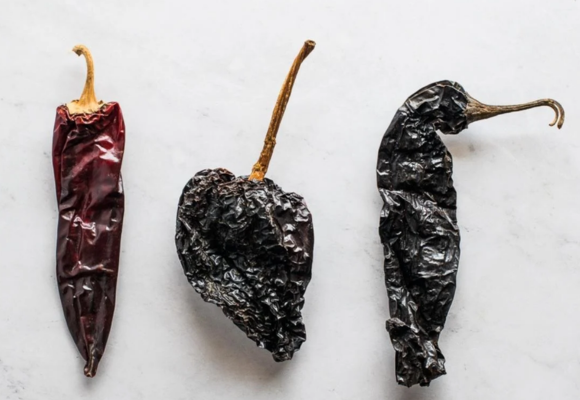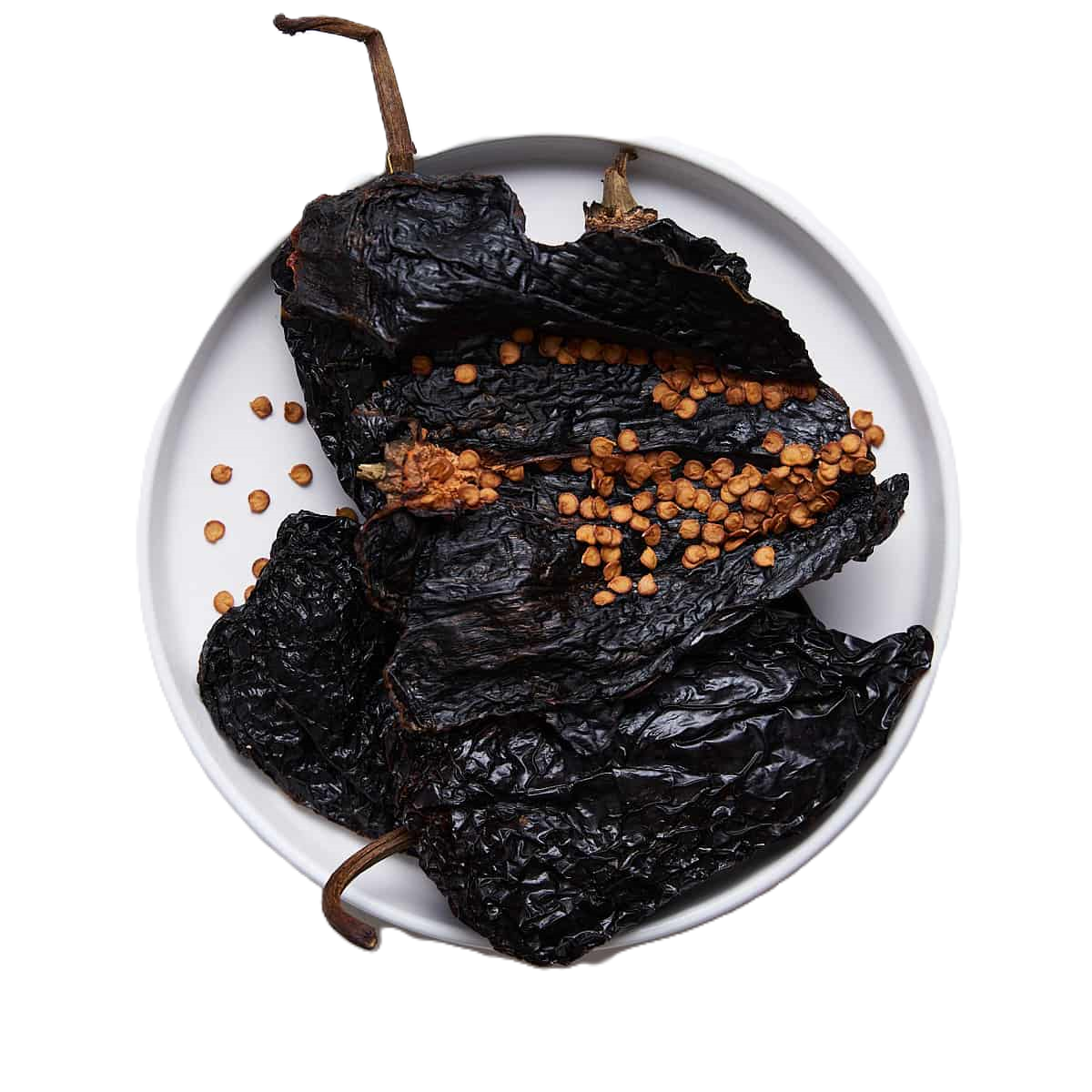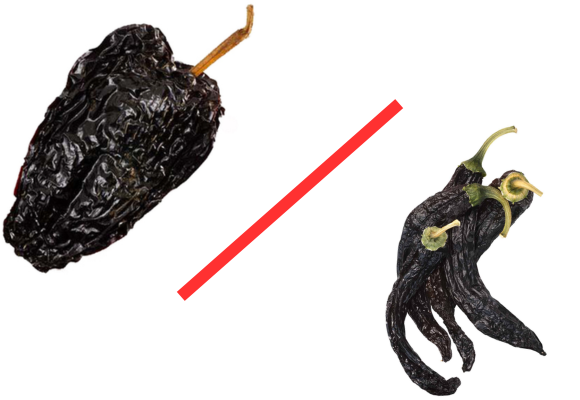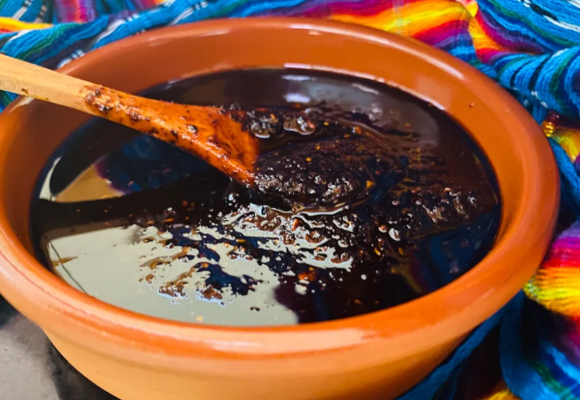The primary reason why dried Mexican Chile peppers are used in Mexican cooking is to add flavor, as not every pepper brings heat and spice with it. There are many renowned Mexican Chile peppers such as Ancho to Chipotle, Cayenne to Guajllo, and many more, but we will only focus and discuss on just Pasilla vs. Ancho for this article.
Pasilla and Ancho are two well-recognized and widely used kinds of dried peppers that, for regular cooking of Mexican food, tend to be its staple ingredients and are a must to be kept around.

Both these peppers are needed if you plan on cooking authentic Mexican food, as many master chefs consider them the holy trinity of Mexican dried chilies, without which the food will be deprived of its Mexican touch.
Pasilla Vs. Ancho
As both peppers trace themselves back to Mexican origin, they are often confounded to have similar flavor, appearance, and heat levels. But in actuality, there exist many variances between Pasilla and Ancho, and we will be discussing some of them.
Spice Levels
Generally, Pasilla and Ancho have more or less the same level of spiciness, and neither of these dried peppers is used in Mexican food as an ingredient with the intention of adding spice or heat.
However, compared to Ancho, Pasilla is slightly spicier, and its spiciness ranges potentially within the low to medium spicy level range. Ancho, essentially dried Poblano Peppers, has the same spiciness as Poblanos, which is 1000-1500 SHU (Scoville Heat Units).

Pasilla is regularly a modified form of dried Chilaca peppers whose spice range or heat levels also extend to Pasilla, and that is 1000-2500 SHU. Thus, it can be seen that Pasilla is spicier than Ancho but not spicy enough to add heat to food.
Popularity
Some readers often even wonder that out of the two Pasilla Vs. Ancho Mexican peppers, which of the two is the most popular? Through comparing the online searches for both the dried peppers, we saw a trend for Ancho to be out of the most frequently searched Mexican pepper and was searched roughly 63,000 times in a month.

On the other hand, Pasilla was approximately only searched 18,800 times, which is not to say that Pasilla is an unpopular pepper, but only that it is not searched as often as Ancho is.
Color And Shape
The color of Pasilla and Ancho is very dark-brown-red, which can often be confused with an almost black. These peppers are ripened to be a very dark color before being extracted and further processed.
Out of the two, Ancho is the more squat pepper that generally is 2 to 3 inches wide and between 4 to 6 inches long. In contrast, Pasilla is 6 to 9 inches in length but in width only an inch in measuring diameter.

Originating Peppers
As we briefly stated before, Pasilla and Ancho have different names before they are dried: Chilaca and Poblanos, respectively. Chilaca and Poblanos are the two fresh chilies from which Pasilla and Ancho trace their origination and are mainly grown in Puebla in central Mexico.
Chilacas and Poblanos are two of Mexican cuisine’s most valued dried pepper chilies and with the inclusion of the Guajillo pepper, the three altogether form the “Mexican holy trinity of dried chilies,” which is used very commonly in Mexican moles.
Pepper Accessibility
If you are someone who has Mexican nationality and are a resident of the United States, then you must know how easily Pasilla Vs. Ancho pepper will be available to you. Fortunately, Ancho is accessible and can be easily found outside of Mexico.
For instance, if you want to go shopping for Ancho peppers inside the US, then you can visit any mainstream or a specific Mexican grocery store. But this accessibility in finding dried peppers is only for Ancho and not for Pasilla, which are hard to find outside Mexico.
Even in the US, you would have to strive hard to locate a store specializing in Mexican foods, as it will be the only grocery store stocking Pasilla.
Commercial Use
As Ancho pepper is the one that is widely accessible and readily available in grocery stores, it is undoubtedly the pepper out of the Pasilla vs. Ancho, which is also used for commercial use.
Through the ground powder and whole Ancho’s convenient availability, they are used in seasoning pastes and sauces that are sold commercially.
Commercially, Ancho is the more prominent pepper, and it is also the chili, which is also used in an American classic powder seasoning style.

Taste
Pasilla and Ancho are well-known for the non-spicy aspects of their flavors in their profile. As these peppers do not have much of a spice or a heat level, they shine through and appear more distinctive than other standard dried Mexican peppers.
Both the peppers have an underlying sweetness, but the flavors that complement their sweetness slightly differ. For example, Pasillas are sweeter than Ancho as they feature a complementary taste of running berry and hints of cocoa that raise the flavor’s sweet, earthy finish.
However, Ancho is sweet, and it’s undertones are earthy and smoky, with the flavor profile having touches of tea and cocoa.
Nutritional Benefits
Both pasilla and ancho chilies are not only flavorful but also packed with nutritional benefits. They’re low in calories and fat, and rich in vitamins A and C, as well as fiber. These chilies also contain capsaicin, which is known for its anti-inflammatory properties and potential health benefits, including improving digestion and metabolism.
| Aspect | Pasilla Pepper | Ancho Pepper |
|---|---|---|
| Origin/Type | A dried form of the chilaca pepper. | A dried form of the poblano pepper. |
| Flavor Profile | Earthy, rich, and sometimes hints of chocolate. | Sweet, slightly smoky, with hints of plum, raisin, and tobacco. |
| Heat Level | Typically ranges from mild to medium-hot. | Generally mild, with a subtle heat. |
| Common Uses | Used in sauces, moles, and as a seasoning in Mexican cuisine. | Frequently used in mole sauces, enchiladas, and other dishes. |
| Appearance | Long, narrow, and dark brown in color. | Broad, heart-shaped, and dark reddish-brown in color. |
| Scoville Scale | Approximately 1,000 to 2,500 SHU (Scoville Heat Units). | Around 1,000 to 1,500 SHU. |
| Texture | More wrinkled and less meaty compared to ancho peppers. | Meatier and softer when rehydrated compared to pasilla peppers. |
| Availability | Readily available in most markets specializing in Mexican cuisine. | Very common and widely available in various markets. |
Pairing with Other Ingredients
Complementary Flavors
Pasilla and ancho chilies pair beautifully with a range of ingredients. Pasillas go well with ingredients like mushrooms, garlic, and herbs, enhancing earthy dishes. Anchos, with their sweeter profile, complement ingredients like chocolate, cinnamon, and fruits in both sweet and savory dishes.
Creating Balanced Dishes
Using these chilies in your cooking involves striking a balance between their flavors and the other components of your dish. For instance, pairing the deeper flavor of pasillas with the sweetness of tomatoes can create a harmonious balance in a sauce. Similarly, anchos can be balanced with acidic ingredients like lime juice or vinegar to create a rounded flavor profile in your dish.
Quick Summary Of The Peppers
Pasilla
Pasilla dried peppers, also known as Chiles Negors, are the dried form of the Chile Chilaca and are thinner and longer in their size compared to the Ancho peppers. Although their flavor is somewhat like that of Ancho, the deep fruit’s additional flavor of prunes and raisins makes them much hotter and spicier.
- Scoville Heat Units (SHU): mild to medium, 1000-2500
- Uses: used mostly in the production of Mexican stews, sauces, and moles
Ancho
Ancho peppers are the dried version of Poblano Peppers and have a smoky and sweet raisin-like flavor, making them even lower in spice and heat level than Pasillas. They are more squat in their shape, wide, and long in their shape.
- Scoville Heat Units (SHU): mild, 1000-1500
- Uses: It is used mostly in Mexican moles, and the great flavor coupled with low heat makes Ancho an ideal pepper to be used during meat marination and in cooking stews and soups.
Can You Use Ancho Peppers For BBQ?
Yes, you can use ancho peppers in BBQ to smoke meat. Ancho peppers, which are dried poblano peppers, are known for their mild heat and sweet, smoky flavor. They can be a great addition to BBQ dishes in various ways:
- BBQ Sauce: Ancho peppers can be ground into a powder and mixed into BBQ sauces to add a unique, smoky flavour that you can use to smoke chicken, beef, or lamb more.
- Dry Rubs: The ground ancho pepper can also be used in dry rubs for meats. It pairs well with other spices like cumin, garlic powder, and paprika.
- Marinades: Soaking ancho peppers in hot water and then blending them into a paste makes a flavorful base for marinades.
- Smoking: Some people also use whole or chopped ancho peppers to add flavor to the smoking process, either by placing them in the smoker or adding them to the coals.
The mild heat level of ancho peppers makes them suitable for a wide audience, and their flavor complements the richness of BBQ meats beautifully.
Conclusion
Pasilla and ancho chilies, with their rich histories, unique flavors, and versatile uses, are more than just ingredients; they are a journey through Mexican culinary tradition. Although Pasilla Vs. Ancho may have previously appeared to be the same in flavor, appearance, and shape but in actuality, significant differences lie between them. Not only is the taste of the peppers different but one is spicier than the other, and the uses are varying.
Frequently Asked Questions
Can I substitute Pasilla for Ancho?
Pasilla is not an ideal substitute for Ancho because its spice level is much higher than Ancho and when used in food, can result in a completely different flavor than you might have anticipated.
Is Ancho and Pasilla the same?
No, ancho and pasilla are not the same. One is more sweeter and spicier than the other. Also, they differ in their shape and the way they are used in the cooking of Mexican food. Although they are often confused due to regional naming differences. In some regions, particularly in parts of the United States, there can be a mix-up in naming, where Pasilla is sometimes incorrectly used to refer to Ancho peppers. However, in authentic Mexican cuisine, these are the distinctly different peppers with their own unique flavours and various uses.
Which is hotter, Ancho or Pasilla?
The Pasilla pepper is generally hotter than the Ancho pepper. so, Pasilla is hotter and features a higher SHU than Ancho, between the range of 1000-2500.
What is a Pasilla called before being dried?
Before being dried, a Pasilla is known to be a Chilaca. The Chilaca is a fresh, long, and narrow pepper with a dark green color. When it is dried, it transforms both in color and in flavor, becoming the Pasilla pepper, which is known for its dark, wrinkled skin and its earthy, rich flavor with occasional hints of chocolate.
